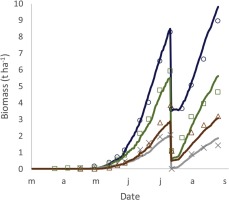当前位置:
X-MOL 学术
›
Eur. J. Agron.
›
论文详情
Our official English website, www.x-mol.net, welcomes your
feedback! (Note: you will need to create a separate account there.)
Simulation using the STICS model of C&N dynamics in alfalfa from sowing to crop destruction
European Journal of Agronomy ( IF 4.5 ) Pub Date : 2020-01-01 , DOI: 10.1016/j.eja.2019.125948 L. Strullu , N. Beaudoin , P. Thiébeau , B. Julier , B. Mary , F. Ruget , D. Ripoche , L. Rakotovololona , G. Louarn
European Journal of Agronomy ( IF 4.5 ) Pub Date : 2020-01-01 , DOI: 10.1016/j.eja.2019.125948 L. Strullu , N. Beaudoin , P. Thiébeau , B. Julier , B. Mary , F. Ruget , D. Ripoche , L. Rakotovololona , G. Louarn

|
Abstract We adapted the STICS agro-environmental model to simulate the effects of cultivation practices on the biomass production and nitrogen accumulation of perennial crops undergoing regular defoliation, using alfalfa as an example. A unique set of parameters was used to simulate both establishment and regrowth phases over several years, with the assumption that crop growth is driven by interaction between crop development stage and abiotic stresses. The model accurately simulated the total biomass (stems + leaves + crown + taproot + roots) and aboveground biomass of the crop, with model efficiencies of 0.75 and 0.70, respectively, and relative root mean squared errors (rRMSE) of 42% and 36%, respectively. The evaluation results were also satisfactory with respect to total nitrogen content and the aboveground biomass nitrogen content, with model efficiencies of 0.90 and 0.60, respectively, and rRMSE values of 29% and 31%, respectively. The model thus enabled simulations of both the establishment and regrowth of alfalfa and accurately reproduced its seasonal patterns of growth, even though it tended to underestimate spring biomass production. It also produced accurate simulations of the water and nitrate contents of the soil during cropping and after crop destruction. It could therefore be a useful tool regarding the multi-criteria assessment of cropping systems based on alfalfa with respect to their sustainability.
中文翻译:

使用 STICS 模型模拟苜蓿从播种到作物毁坏的 C&N 动力学
摘要 我们以苜蓿为例,采用 STICS 农业环境模型来模拟种植实践对定期落叶的多年生作物的生物量生产和氮积累的影响。一组独特的参数用于模拟几年的建立和再生阶段,假设作物生长是由作物发育阶段和非生物胁迫之间的相互作用驱动的。该模型准确模拟了作物的总生物量(茎+叶+冠+主根+根)和地上生物量,模型效率分别为0.75和0.70,相对均方根误差(rRMSE)分别为42%和36% , 分别。总氮含量和地上生物量氮含量的评价结果也令人满意,模型效率分别为 0.90 和 0.60,rRMSE 值分别为 29% 和 31%。因此,该模型能够模拟苜蓿的建立和再生,并准确再现其季节性生长模式,尽管它倾向于低估春季生物量产量。它还对作物种植期间和作物毁坏后土壤的水分和硝酸盐含量进行了准确模拟。因此,它可以成为对基于苜蓿的种植系统可持续性进行多标准评估的有用工具。尽管它倾向于低估春季生物量产量。它还对作物种植期间和作物毁坏后土壤的水分和硝酸盐含量进行了准确模拟。因此,它可以成为对基于苜蓿的种植系统可持续性进行多标准评估的有用工具。尽管它倾向于低估春季生物量产量。它还对作物种植期间和作物毁坏后土壤的水分和硝酸盐含量进行了准确模拟。因此,它可以成为对基于苜蓿的种植系统可持续性进行多标准评估的有用工具。
更新日期:2020-01-01
中文翻译:

使用 STICS 模型模拟苜蓿从播种到作物毁坏的 C&N 动力学
摘要 我们以苜蓿为例,采用 STICS 农业环境模型来模拟种植实践对定期落叶的多年生作物的生物量生产和氮积累的影响。一组独特的参数用于模拟几年的建立和再生阶段,假设作物生长是由作物发育阶段和非生物胁迫之间的相互作用驱动的。该模型准确模拟了作物的总生物量(茎+叶+冠+主根+根)和地上生物量,模型效率分别为0.75和0.70,相对均方根误差(rRMSE)分别为42%和36% , 分别。总氮含量和地上生物量氮含量的评价结果也令人满意,模型效率分别为 0.90 和 0.60,rRMSE 值分别为 29% 和 31%。因此,该模型能够模拟苜蓿的建立和再生,并准确再现其季节性生长模式,尽管它倾向于低估春季生物量产量。它还对作物种植期间和作物毁坏后土壤的水分和硝酸盐含量进行了准确模拟。因此,它可以成为对基于苜蓿的种植系统可持续性进行多标准评估的有用工具。尽管它倾向于低估春季生物量产量。它还对作物种植期间和作物毁坏后土壤的水分和硝酸盐含量进行了准确模拟。因此,它可以成为对基于苜蓿的种植系统可持续性进行多标准评估的有用工具。尽管它倾向于低估春季生物量产量。它还对作物种植期间和作物毁坏后土壤的水分和硝酸盐含量进行了准确模拟。因此,它可以成为对基于苜蓿的种植系统可持续性进行多标准评估的有用工具。









































 京公网安备 11010802027423号
京公网安备 11010802027423号